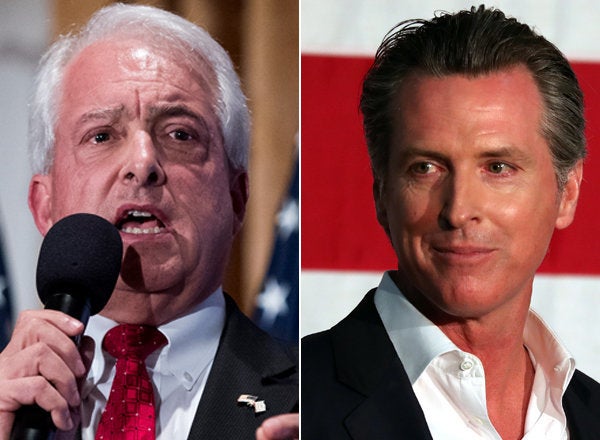Democratic Lt. Gov. Gavin Newsom and Republican businessman John Cox placed first and second, respectively, in California’s gubernatorial primary Tuesday, according to projections from Fox News and NBC, easing Republican fears that their party would be entirely shut out of the general election in November.
Newsom and Cox competed in a crowded field to replace outgoing Gov. Jerry Brown (D) in the state’s “jungle” primary, in which the top two vote-getters advance to the general election. Other candidates included former Los Angeles Mayor Antonio Villaraigosa (D), state Treasurer John Chiang (D), former state public schools chief Delanie Eastin (D) and state Assemblyman Travis Allen (R).
As the results of the primary were called Tuesday evening, Villaraigosa asked officials to keep some polling stations in Los Angeles County open through Friday because of a printing error that had left more than 118,000 names off the voter rolls. “We’ve been told that a number of people were turned away and weren’t allowed to cast a provisional ballot,” he said at his election night event. “We’ve got to figure that out.”
Later in the evening, Villaraigosa conceded the race and threw his support behind Newsom.
Newsom announced his candidacy in February 2015 — more than three years before the primary — and has dominated the race in both the polls and fundraising ever since. He’s widely expected to defeat Cox in the general election: Republicans haven’t won a statewide race in California since 2006, and the GOP businessman is not nearly as well known statewide as the lieutenant governor. Cox is also a relatively recent California transplant, having lived in Chicago most of his life, and has never been elected to public office.
Newsom pitched himself to voters as a bold advocate for California and offered support for progressive policies like Medicare for all and universal preschool while looking to convince more moderate voters he’d continue in Brown’s budget-conscious path. He’s also said he’d be a more pro-active governor than Brown, who largely does not comment on legislation until it’s time for him to sign or veto it.
“I’m going to pull a lot more things into the governor’s office and not just see them fester in the Legislature,” Newsom told reporters last week.
Cox, meanwhile, has vowed to reform the state’s taxation system if elected, particularly taking issue with the state’s high income taxes. He’s also taken on the state’s gas tax — a favorite punching bag of California Republicans — as well as California’s newly implemented “sanctuary” state policy. He’s also pushed a plan to reduce the size of the state’s legislative districts, which he’s argued would reduce corruption by cutting down on the need for special interest money in campaigns.
For most of the campaign, Villaraigosa was seen as the most viable threat to Newsom’s candidacy. He has strong ties to Southern California, having served as Los Angeles mayor for two terms, and serving on the Los Angeles City Council as well as in the California Assembly prior to that. Newsom, who was the mayor of San Francisco before assuming his current statewide post, is a Bay Area native with a deep support base in the northern part of the state.
Villaraigosa, who is Mexican-American, also had strong support from Latino voters, who made up roughly 18 percent of likely voters.
But in the last month of the campaign, Cox, a San Diego County resident who supported Libertarian Gary Johnson in the 2016 presidential race, earned the support of President Donald Trump, which pushed him over the edge to best Villaraigosa in the race for second place.
Trump’s endorsement, however, may work against Cox in the general election: In a statewide UC Berkeley IGS Poll conducted in April, just 31 percent of voters said they approved of the president’s job performance.
California’s top-two primary system prompted some unusual maneuvers in the late stages of the campaign. Hoping for the opportunity to run against a Republican rather than waging a costly campaign against a fellow Democrat, Newsom’s campaign ran “attack ads” against Cox that likely endeared GOP voters to the businessman by playing up his ties to the National Rifle Association as well as his Trump endorsement.
A super PAC supporting Villaraigosa’s campaign, meanwhile, spent more than $1 million boosting Allen’s candidacy in hopes of splitting the GOP vote.

